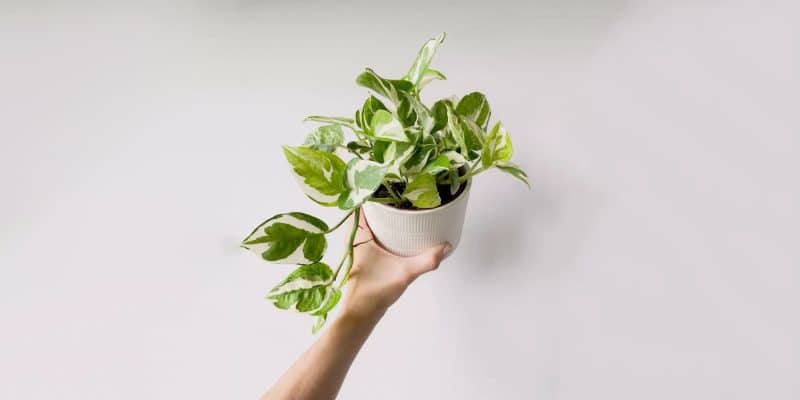One of our absolute favorite plants has to be the N Joy Pothos. This fantastic houseplant isn’t just easy on the eyes but also a breeze to care for — even if your thumb is less green and more, well, any other color.
A member of the pothos family, the N Joy Pothos sports trailing heart-shaped leaves with light green and white variegation that really spruces up a home.
We’re going to dig into the nitty-gritty of N Joy Pothos care, from its unique features to any issues that might crop up. A plant you’ll definitely enjoy? Without a doubt!
Table of Contents
N Joy Pothos Plant Care Guide
History, Habitat, and Characteristics
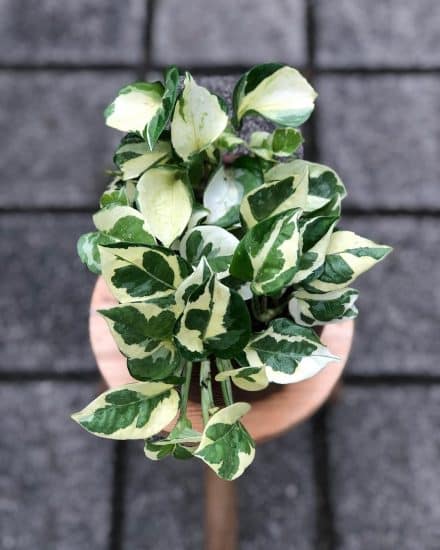
N Joy Pothos (Epipremnum aureum ‘N Joy’), a natural branch mutation of Marble Queen pothos, has eye-catching variegated leaves. Originally hailing from French Polynesia, Epipremnum aureum has seen countless cultivars over time, of which the N Joy pothos is just one.
(By the way, it’s also known as NJoy Pothos or N’Joy Pothos).
If there’s one thing we houseplant enthusiasts can’t agree on, it’s common names. For example, the NJoy Pothos also goes by the name “Marble Queen pothos,” although there are actually very subtle differences between the two plants.
What sets the NJoy Pothos apart from other pothos varieties like the Jade pothos (all green) and the Snow Queen pothos (almost all white) is its marbled white and green variegation, as well as its compact but still vining growth habit.
Basically, the NJoy pothos is actually smaller than the Marble Queen pothos, and you may see a broader variation of color in NJoy than in Marble Queen. Plus, NJoy Pothos has blotchier markings, rather than the Marble Queen’s streaks.
While NJoy pothos is generally as low-maintenance as other pothos varieties, its variegation does require a bit more sunlight. Give this queen the royal treatment by providing a bit more light to help maintain its vibrant colors.
Light
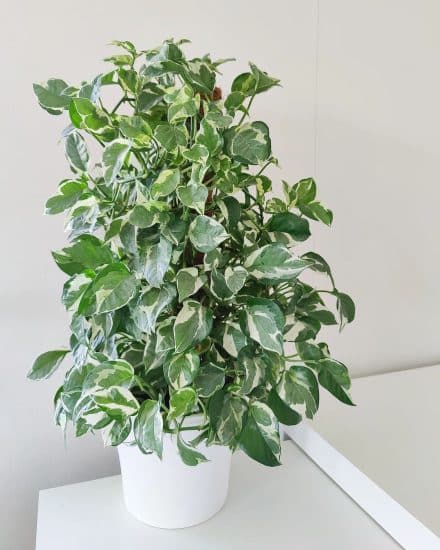
Because of its variegation, Pothos N’Joy has stricter lighting needs than other pothos plants.
Ideally, Epipremnum aureum ‘NJoy’ is happiest in medium to bright indirect light, although it can adapt to higher light settings if necessary. Just remember that low light conditions might spell doom for this plant, particularly its delightful variegation.
If your N’Joy Pothos isn’t basking in enough light, you’ll see the white parts of its leaves turning green (and not in a good way!). To maintain that healthy variegation, make sure the plant gets sufficient bright light, particularly during the winter months or when your home isn’t quite as sunny as it should be.
On the flip side, too much direct light may cause signs of phytotoxicity, or too much sun. The spaces between the plant’s nodes get too big, leaving you with a less lush, less bushy pothos. You may also witness scorching, crispiness, and browning of the leaves.
If you can manage it, the nearest natural light source should be an east- or west-facing window. North-facing windows may not get enough sun, and south-facing windows may get too much.
Our lighting tips:
- Give your N’Joy Pothos medium to indirect bright light for optimal growth.
- Amp up the light with a grow light if needed, especially when winter rolls around or when your home’s natural brightness is on the dim side.
- Keep an eye on the plant’s internodal spaces to check if it’s getting too much light, and adjust its location accordingly.
- Use a sheer curtain to diffuse direct light if your pothos is in a southern window.
- Avoid low light conditions. N’Joy Pothos needs a good amount of light to maintain its tell-tale variegation.
Water
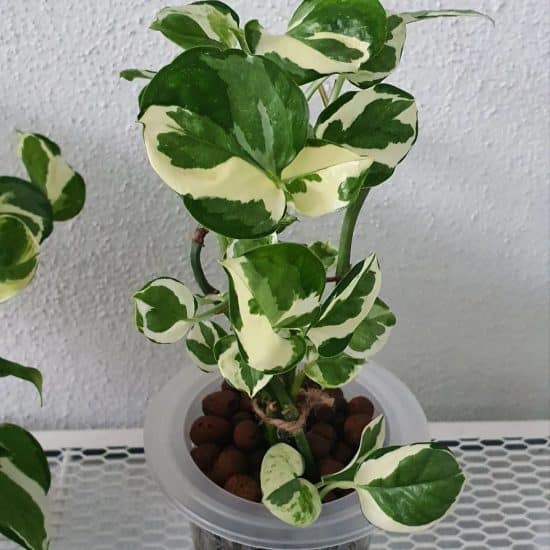
Few plants are easier to take care of than a pothos, and that goes for watering as well as lighting. Knowing when to water your NJoy Pothos is straightforward: When the top half of the soil is dry, water it.
The lovely thing about pothos plants is that when they’re thirsty, they’ll droop a bit to let you know they’re ready for a drink. Just don’t let it stay droopy too long.
To ensure your NJoy Pothos gets the right amount of moisture, saturate the soil completely, letting the water drain through the pot’s drainage holes. Wait for the soil to dry before watering again.
If your NJoy Pothos is underwatered, you’ll see the oldest leaves — those closest to the soil — turning bright yellow. To address this, increase the watering frequency and remove dying leaves to prevent pests. Curled leaves also indicate underwatering.
Too much water also results in yellowing leaves, but throughout the plant, as well as mushy stems and constantly damp soil. In this case, reduce watering frequency and allow the soil to dry out.
During winter, when your NJoy Pothos is growing more slowly, reduce the watering frequency accordingly. It’s not unheard of to let a pothos dry out completely in the winter.
Temperature and Humidity
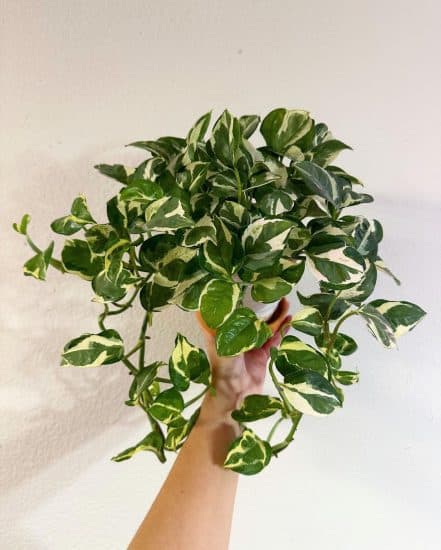
When it comes to temperature and humidity, pothos plants won’t give you too much trouble. The ideal temperature range for N’Joy Pothos is 65°-85°F (18°-29°C). These plants adapt well to indoor environments, but avoid exposing them to sudden temperature changes.
Yellowing leaves may indicate that the temperature is too high or too low. Keep your N’Joy Pothos plant away from cold drafts, direct light, and heating vents to prevent temperature-related stress.
Like most pothos plants, the N’Joy pothos likes average humidity. Your N’Joy Pothos will prefer humidity levels between 40%-60%. To maintain consistent humidity, you can add air moisture, but it’s also essential to promote good air circulation. Keep in mind that simply misting your plant won’t effectively raise the ambient humidity.
Air that’s too dry may cause leaf browning or curling leaves with crispy tips. Excessive moisture, on the other hand, may lead to issues with the root system, fungal problems such as mold, and musty smells.
To raise humidity:
- Run a humidifier near your Pothos N’Joy.
- Group plants together to create a more humid microclimate.
- Place your Pothos N’Joy on a pebble-filled tray with water, ensuring the pot sits above the waterline and has drainage holes to prevent excess water or wet soil.
- Move the plant to a naturally humid room, like a bathroom or kitchen.
By following these guidelines, you’ll create the perfect environment for your Pothos N’Joy to flourish and enjoy healthy growth.
Soil and Planting
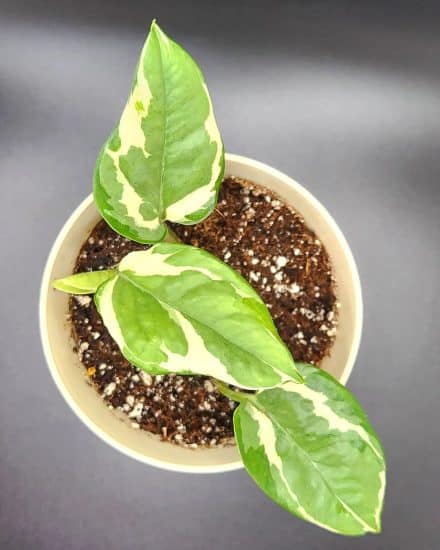
The N’Joy Pothos thrives in a free-draining, airy aroid mix, perfect for promoting healthy roots. Use a well-aerated potting soil with good water retention for optimal results.
Avoid adding too many elements that will retain moisture, like peat moss or coconut coir, to your soil mixture. Focus instead on mixing fresh potting soil with perlite or orchid bark.
The pothos is a truly versatile plant when it comes to potting. I have pothos stems that I’ve been growing in just water for years. N’Joy Pothos can be grown either as a trailing or climbing plant when grown indoors, so it’s perfect for a hanging basket.
Try to leave your Pothos NJoy in its original nursery pot as long as possible. When it eventually outgrows it, choose a pot that’s only a few inches wider and taller to avoid overwatering. Repot Pothos NJoy during the spring and summer when the plant is at its strongest.
Fertilizing
During the active growing season, the spring and summer months, remember to fertilize your N’Joy Pothos every time you water with a balanced liquid fertilizer (20-20-20 for synthetic or 1-1-1 or 2-2-2 for organic).
Be cautious not to over-fertilize, which can lead to issues such as leaf burn or weak growth. Signs of too much fertilizer include yellow leaves, browning leaf tips, or a general decline in the plant’s health.
To remedy this, flush the soil with water to help remove excess fertilizer salts and reduce the frequency of fertilization.
Propagation
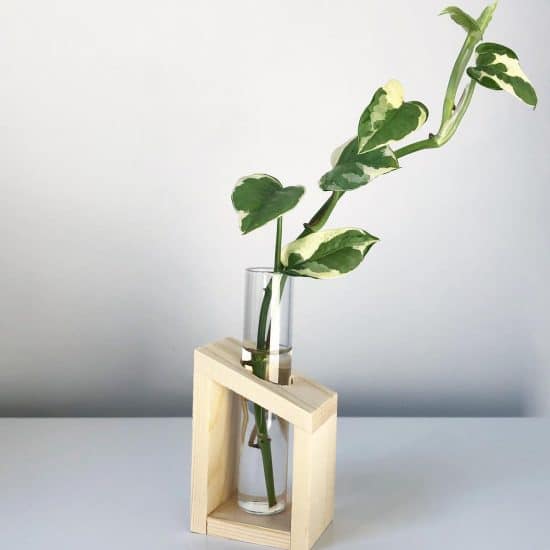
N’Joy Pothos propagation is super fun and easy, and cutting stems for propagation also helps your mother plant grow bushier, fuller, and stronger. You can use stem cuttings and choose between two popular methods: water or soil propagation.
Propagating N’Joy Pothos via stem cuttings:
- Snip a stem cutting. First things first, grab your clean pruning shears and cut a healthy stem just below one of the nodes. Choose a stem that’s around 4-6 inches long with a minimum of two healthy leaves.
- Pick your propagation method. You can place the N’Joy Pothos cuttings in either water or a chunky, well-draining potting soil. Both methods can yield success, so pick the one that suits your style or simply try both!
- Prepare the stem cuttings for propagation. Gently remove any leaves from the bottom part of the cutting to prevent them from decaying in your chosen medium.
- Propagate in water. Fill a small container with filtered water and pop the cutting in.
- Propagate in soil. For the soil propagation fans, plant the stem cutting directly into a well-draining potting soil mix. Make sure the node where you took the cutting is covered by the soil, as that’s where the new roots will sprout.
- Protect from direct sunlight. Find a spot with bright, indirect light for your future Pothos N’Joy plant, and remember to either change the water or moisten the soil every few days.
- Plant your cutting. Keep an eye out for new roots growing that are at least an inch long — that’s your cue to transplant your N’Joy Pothos into a decorative pot with well-draining soil.
Our propagation tips:
- Always use sterilized pruning shears when taking a stem cutting to protect your N’Joy Pothos from infection or damage.
- Lighting is key! To encourage healthy growth, place your N’Joy Pothos cutting in a brightly lit area with no direct sunlight, regardless of the propagation method you choose.
- Want a bushier appearance for your N’Joy Pothos plant? Trim it back without propagating! The plant will grow more densely, giving you that lush look you’re after.
Common Issues
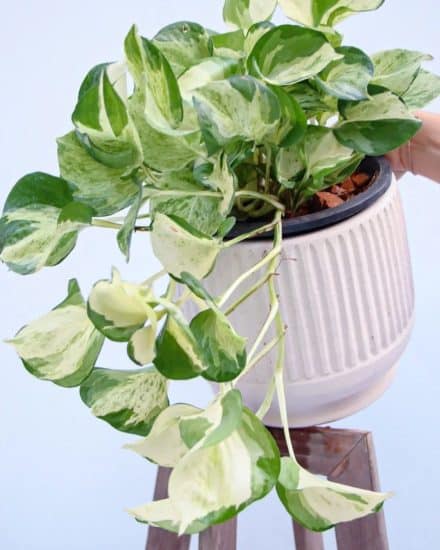
N’Joy Pothos plants are generally easy to care for, but they can still face some challenges that might require your attention.
Leggy Growth
Without proper care, NJoy Pothos may get leggy. There’s more than one cause of legginess in pothos plants, including insufficient pruning, low light, and inconsistent growth habit.
Insufficient pruning or trimming of N’Joy Pothos plants leads to elongated, scraggly stems that detract from the plant’s bushy appearance.
To promote a fuller look, regularly prune your plant by cutting back the longer stems. The cut stems will produce new leaves for a bushier look, and you can use the cut stems for pothos propagation — they make great gifts.
Too little light can also cause your NJoy Pothos to get leggy. Ensure your pothos is situated in a well-lit, warm area.
Another essential aspect of preventing leggy growth is choosing a consistent growth direction for your N’Joy Pothos. Switching between trailing and climbing growth can stress the plant and hinder its development.
Consider your space and choose the growth direction that suits it best, then commit to that choice for optimal results.
Stunted Growth
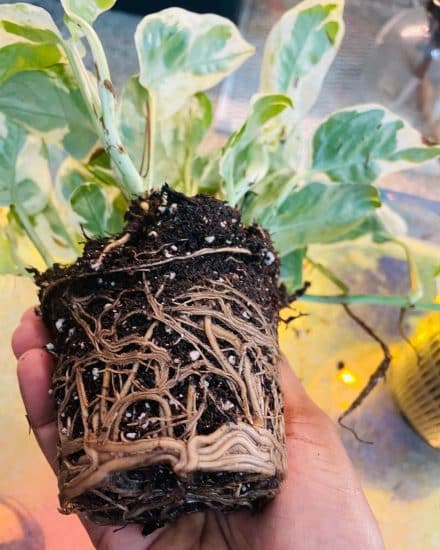
Stunted growth is usually a sign of one of two things: over-fertilization or a root-bound plant.
If you give a pothos too much fertilizer, it will have the opposite effect. Only use a fertilizer intended for indoor plants, and make sure to read the instructions for how much to add. If you do over-fertilize, flush the soil with plain water and reduce your application.
A root-bound plant may have considerably slowed growth. The root system develops to support the plant, and if the roots are struggling, it can’t do that properly — hence, slow or stunted growth.
If it’s been a while since you repotted your N’Joy Pothos, lift it from its pot and inspect the roots growing in the soil. If they’re twisted up on the outside of the soil, it’s time for a bigger pot.
Keep in mind, though, that plants grow slower in the winter than in the summer. Slow growth in winter may not be a sign of problems, but slow growth in summer probably needs evaluating.
Dull Variegation
Dull variegation in N’Joy Pothos plants is often an indication that the plant isn’t receiving enough light. The lack of light can cause leaves to become more green and less white, resulting in duller variegation.
Proper lighting is crucial for maintaining those beautiful variegated leaves, so position your pothos in a bright spot with plenty of indirect sunlight. (Remember that direct sunlight can scorch the leaves and cause yellowing or browning).
Maintaining a consistent environment is another key factor in preventing dull variegation in your N’Joy Pothos. Sudden changes in temperature, humidity, or light levels can stress the plant, causing its variegation to fade.
Pests and Diseases
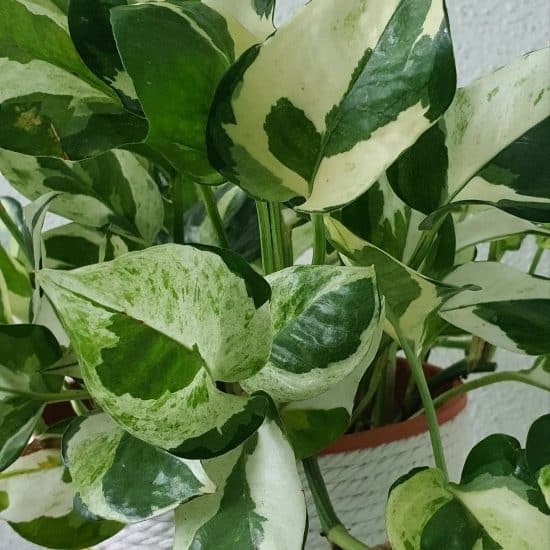
NJoy Pothos plants are generally hardy and easy to grow indoors, but they can still encounter a few common issues like mealybugs, brown patchy leaves, and root rot.
Mealybugs, Spider Mites, and Fungus Gnats
Keeping a plant indoors means watching carefully for pests.
Mealybugs will present as a cottony substance on your leaves and stems. These tiny, white, cotton-like insects can be quite sneaky, sucking the sap from your NJoy Pothos plant and causing the leaves to turn yellow and eventually drop off.
Spider mites are quite different. They prefer dry conditions, and they’re recognizable by the wispy webs they drape across the stems. The leaves may also feel dusty or gritty when you rub them.
The mites themselves are quite small, but not microscopic. You can see them with the naked eye, but they’re smaller than aphids.
Fungus gnats, on the other hand, love moist soil. They lay eggs in wet soil and the larvae feed on your plants roots. Only the worst infestations will damage your plant, but they are annoying.
The best way to deal with fungus gnats is to not keep the soil moist. Avoid overwatering and you should be good.
If you do happen to see any pests on your NJoy Pothos or in the soil, don’t panic! First, isolate the infected plant to prevent their spread.
Gently wipe off the mealybugs and spider mites using a damp cloth or cotton swab dipped in rubbing alcohol. You can also give your plant a thorough spray with insecticidal soap or neem oil (covering all leaf surfaces, of course). If needed, repeat treatments until the infestation disappears.
You can use sticky traps to catch fungus gnats, but severe infestation may require repotting with all new potting soil.
Brown Patchy Leaves
Brown patches on your NJoy Pothos leaves can be caused by excess moisture sitting on the foliage. To prevent this issue, make sure to keep the leaves dry by watering the plant at the base and avoiding misting, which doesn’t help the plant much at all.
If you do find brown patchy leaves, carefully remove the affected leaves and focus on improving your plant’s growing environment. Use a small fan to increase air circulation around the plant, helping any moisture on the leaves evaporate faster.
Root Rot
This is a common issue in houseplants, including NJoy Pothos, and happens when roots are constantly damp due to overwatering or poor drainage. Symptoms of root rot include yellowing leaves, wilting, and a foul, rotting odor coming from the soil.
To tackle root rot, gently remove your NJoy Pothos from its pot and take a close look at the roots. Using clean, sterilized scissors or pruning shears, cut away any mushy, slimy, black, or brown roots.
After pruning the affected roots, repot your plant in fresh, well-draining soil with added perlite, pumice, or LECA for better aeration and drainage, which your plant will appreciate.
Double-check that your plant’s pot has proper drainage holes, and remember to water your NJoy Pothos only when the top inch of soil feels dry.
Conclusion
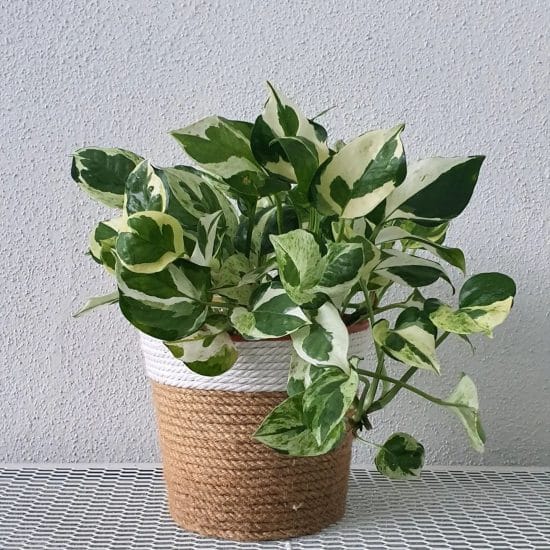
That wraps up our NJoy Pothos guide! With its gorgeous variegated leaves and easy-to-grow nature, this beautiful houseplant is the perfect addition to any indoor space.
NJoy Pothos care summary:
- Give your plant medium to bright indirect light to maintain its gorgeous variegation.
- Maintain a consistent environment with temperatures between 65°-85°F (18°-29°C) and humidity levels of 40%-60%.
- Prune your pothos regularly to promote a full look and prevent legginess.
- Use a well-draining, aerated soil mix and ensure proper drainage to prevent root rot.
- Fertilize during the growing season with a balanced fertilizer, being cautious not to over-fertilize.
- Propagate easily through stem cuttings, either in water or soil, for more NJoy Pothos plants.
By following our care guide, you’ll be well equipped to grow and maintain a thriving NJoy pothos plant.
If you found our guide helpful, share it with your friends and fellow plant enthusiasts! Don’t hesitate to reach out if you have any questions about NJoy Pothos or any other houseplants.
Take care, and happy growing!
FAQ
What is the difference between N Joy, Pearls, and Jade pothos?
While all three cultivars can be traced back to the Marble Queen pothos, NJoy has the lightest green variegation with a white background. Pearls and Jade only have a few hints of cream, white, and green on their leaves.
Is NJoy Pothos toxic?
Yes. Like all pothos, NJoy Pothos is toxic to pets and small humans because of the calcium oxalate its leaves produce. It’s best to keep this plant away from tiny hands and paws.

